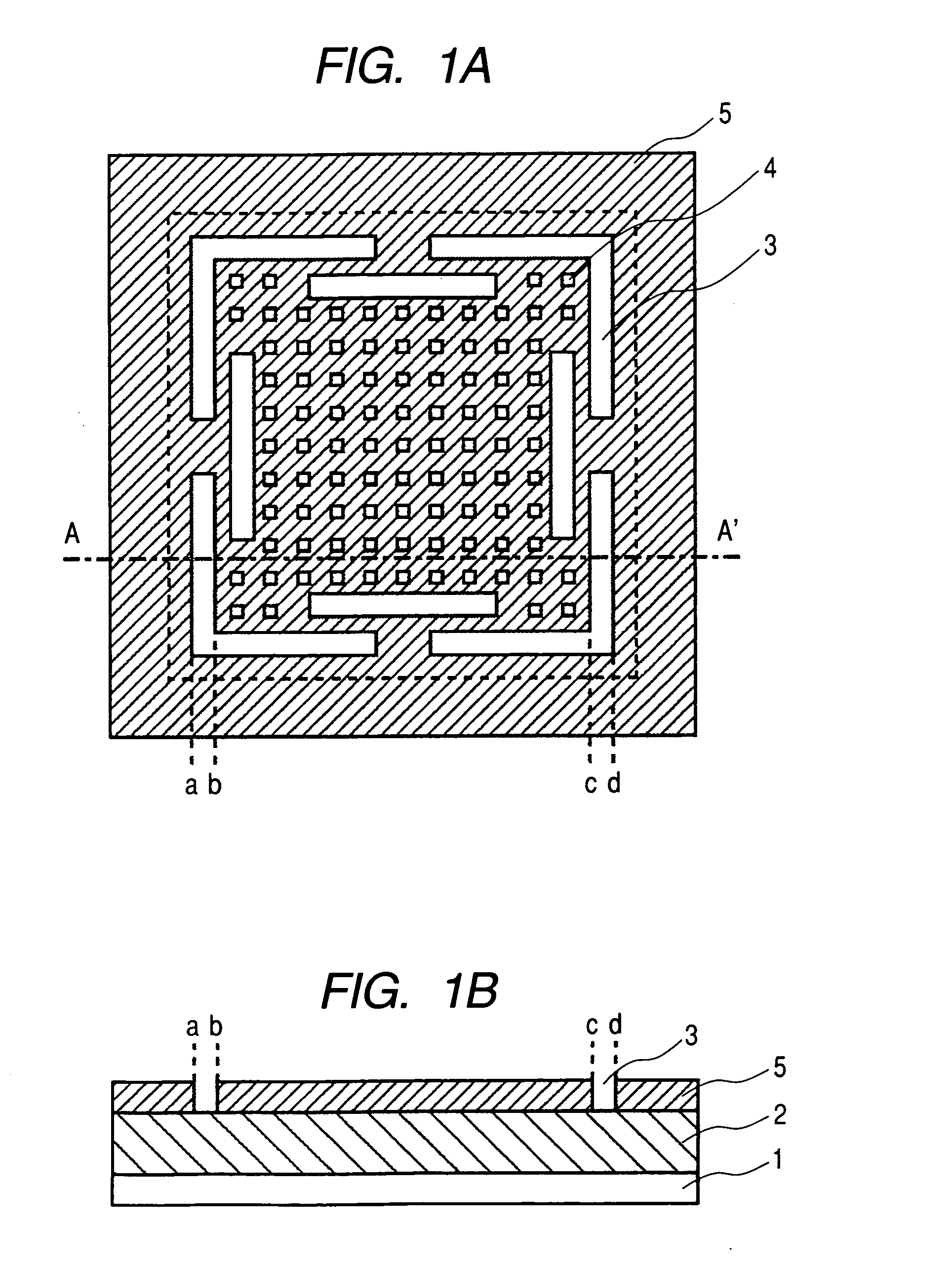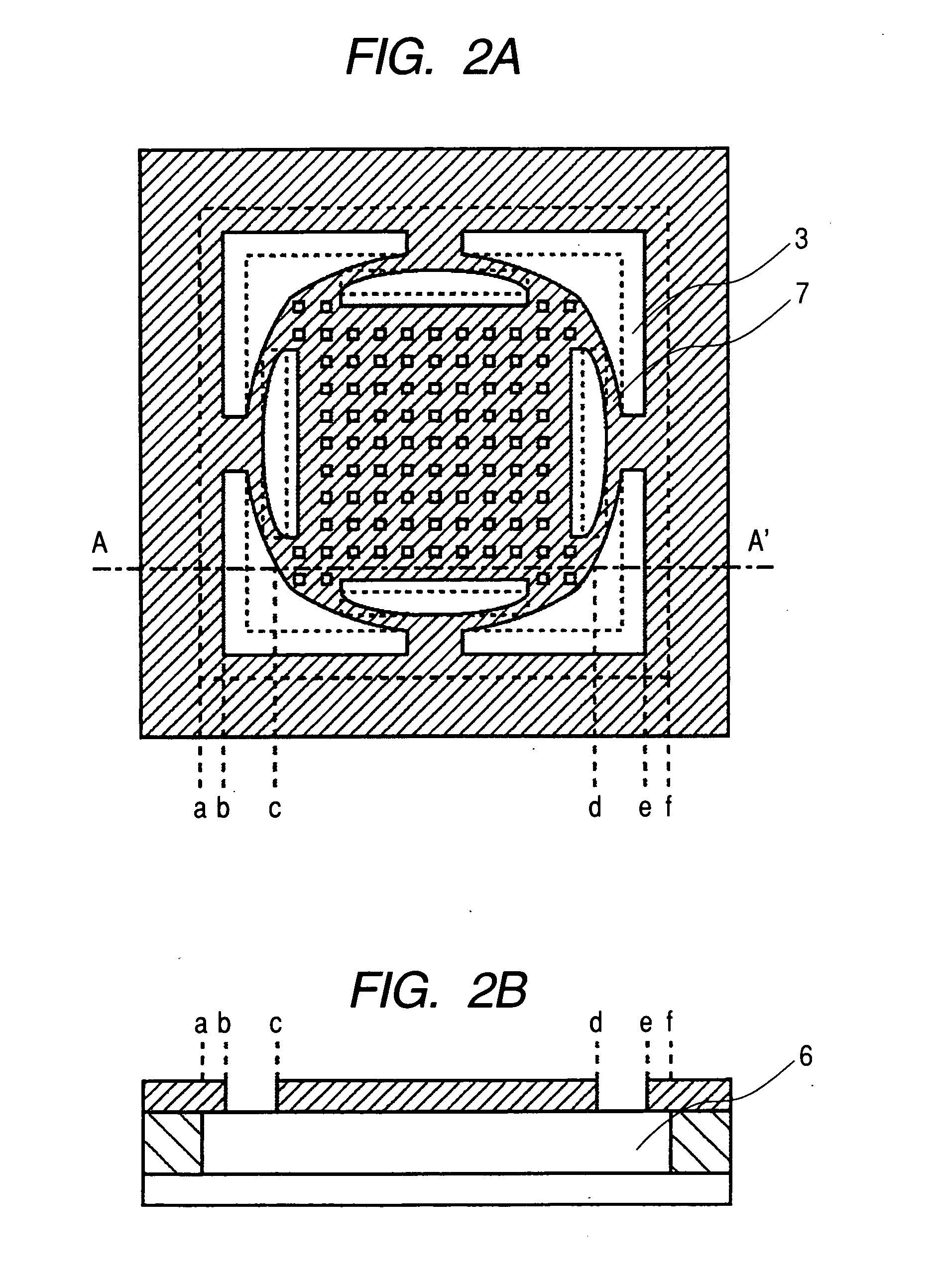MEMS device and manufacturing process thereof
a technology of microelectromechanical systems and manufacturing processes, applied in the field of microelectromechanical systems (mems) devices and manufacturing processes thereof, can solve the problems of reduced yield, cost increase, and special cavity forming and sealing steps of conventional mems devices
- Summary
- Abstract
- Description
- Claims
- Application Information
AI Technical Summary
Benefits of technology
Problems solved by technology
Method used
Image
Examples
first embodiment
[0069]A biaxial acceleration (vibration) sensor according to a first embodiment of the present invention will be described.
[0070]FIGS. 4A, 4B and 4C and FIGS. 5A, 5B and 5C are each a schematic cross-sectional view for explaining the manufacturing process of the sensor according to this embodiment, while FIGS. 6A and 6B are each a schematic view of a plane pattern in each layer of the main process step.
[0071]In accordance with the conventional process of a CMOS integrated circuit, a signal-processing integrated circuit transistor 102 for sensor, contact 103 and multilevel interconnects 104 are formed over a Si substrate 101. An interlayer film 106 made of a Si oxide film is formed over a fourth-level interconnect layer 105 by plasma CVD. After planarization by CMP (chemical mechanical polishing), a first sensor via 107 is formed (FIG. 4A). The first sensor via 107 connects between a predetermined interconnect of the fourth-level interconnect layer 105 and a first layer which will be...
second embodiment
[0086]An angular rate sensor (vibration gyroscope) according to a second embodiment of the present invention will next be described. In this Embodiment, a vibration body is formed by the SOI (Silicon On Insulator) process and then sealed by the LSI wiring process.
[0087]FIGS. 9, 10 and 18 are schematic views illustrating the planar configuration of a structure pattern in each layer constituting the vibration gyroscope, while FIG. 11 is a schematic view illustrating the manufacturing process of the vibration gyroscope according to this embodiment.
[0088]FIG. 9 is a plan view of the SOI layer constituting the vibration body. A layer corresponding to the first sensor layer of Embodiment 1 is also called “first sensor layer”. The first sensor layer pattern is a so-called vibration gyroscope sensor and it has a tuning-fork structure in which two vibration bodies subjected to vibration separation in an actuation (x) direction and a detection (y) direction have been coupled mechanically.
[008...
third embodiment
[0099]An application example of the present invention to an ultrasonic transducer will next be described as an application example to the formation of a diaphragm of a large area.
[0100]FIG. 12 is a schematic view illustrating the planar configuration of a pattern of a layer constituting a diaphragm of the ultrasonic transducer according to this embodiment, while FIGS. 13 and 14 are each a schematic view explaining the manufacturing process of the ultrasonic transducer according to this embodiment.
[0101]FIG. 12 is a plan view of a layer to be a lid of the cavity of the ultrasonic transducer (at the time of etching of a sacrificial layer). This layer corresponding to the second sensor layer of the second embodiment will hereinafter be also called second sensor layer. Different from the second sensor layer of the second embodiment, no minute etching holes are made in this embodiment. With regard to the cross-shaped slits, similar to those of the second embodiment, they have, at the nar...
PUM
 Login to View More
Login to View More Abstract
Description
Claims
Application Information
 Login to View More
Login to View More - R&D
- Intellectual Property
- Life Sciences
- Materials
- Tech Scout
- Unparalleled Data Quality
- Higher Quality Content
- 60% Fewer Hallucinations
Browse by: Latest US Patents, China's latest patents, Technical Efficacy Thesaurus, Application Domain, Technology Topic, Popular Technical Reports.
© 2025 PatSnap. All rights reserved.Legal|Privacy policy|Modern Slavery Act Transparency Statement|Sitemap|About US| Contact US: help@patsnap.com



